Battle of the Crater, July 30, 1864
Introduction
Text-to-speech Audio
Images
Picture of the Crater. Union soldiers are inside the crater after capturing the city of Petersburg. 1865.
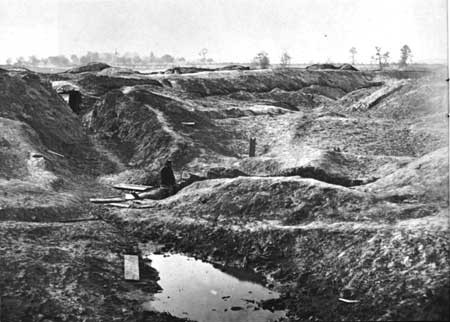
"Recapture the Crater", by Henry Kidd
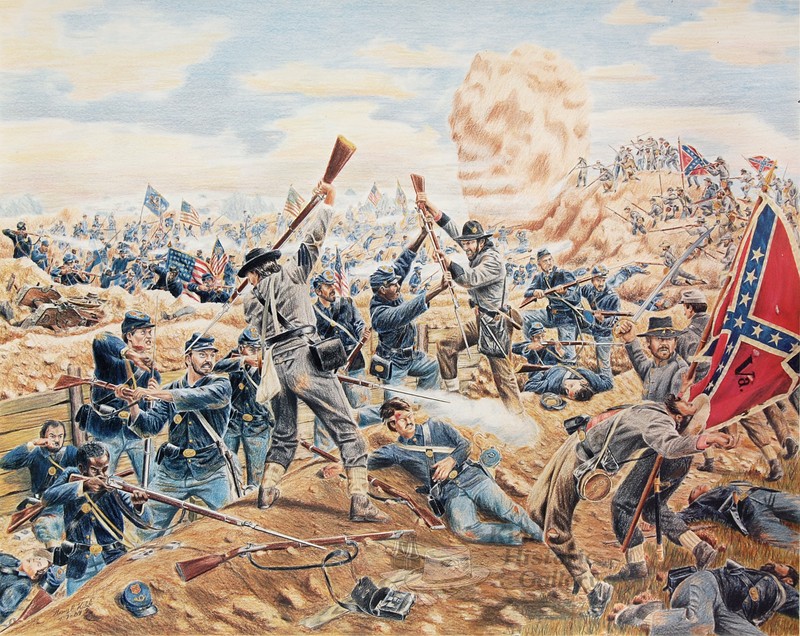
Picture of the what remains of the Crater today
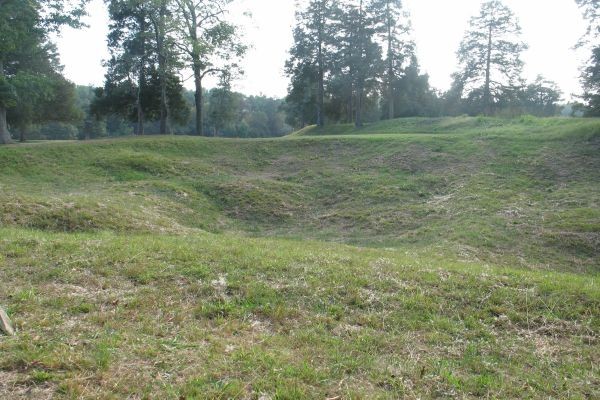
Reconstructed entrance to mine tunnel

An Alfred Waud on-the-scene-sketch of the the mine explosion, July 30th, 1864
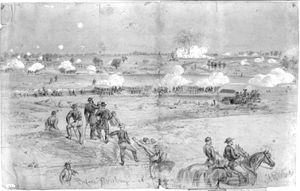
Rendition of the men working in the mine tunnel
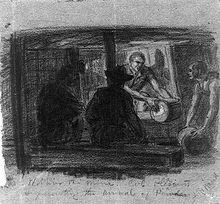
What the tunnel may have looked like
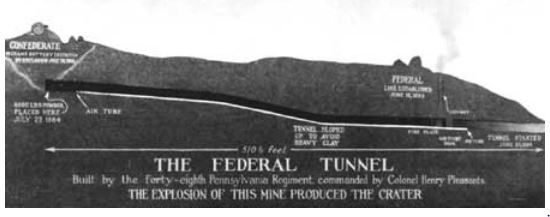
Another on-the-scene-sketch of the explosion
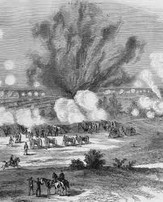
An ariel rendition of how the fighting in the Crater may have appeared.
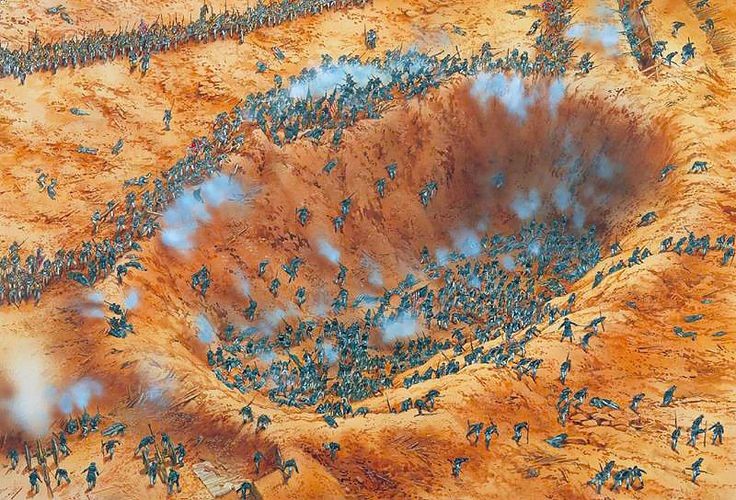
The explosion as portrayed in the film "Cold Mountain"
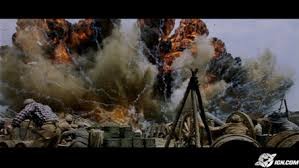
Backstory and Context
Text-to-speech Audio
The Union siege of Petersburg had become a stalemate as Confederate defenders behind what appeared to be an impregnable line were able to prevent a Union advance on their position. Colonel Henry Pleasants, a mining engineer from the 48th Pennsylvania, noticed that there was a narrow piece of land separating the Union position from the Confederate defenders at Edward's Salient. He recommended the building of a mine shaft under the Confederate stronghold and placing dynamite under the defenders. With one explosion, the engineer predicted, the Union might be able to break the line of Confederate defenders and rush troops into this narrow gap. Despite having reservations about the ambitious and dangerous plan, Union commanders approved the operation and engineers began digging of the mine shaft in June of 1864. It took Union forces a month to dig and fill the mine with 8,000 pounds of gunpowder.
General Ambrose Burnside enthusiastically supported his engineer's plan and Grant approved the plan despite some initial reservations. He had four divisions at his command and decided to train one of those divisions for a special mission-- to enter the gap in the Confederate line that would be caused by the explosion. The plan was for this division of shock troops enter the mine shaft and resulting crater as quickly as possible and then move behind enemy lines and cause as much damage to nearby Confederate defenders and defenses so that the other three divisions could launch a frontal attack.
General Burnside selected Brigadier General Edward Ferrero’s division of African American troops to lead the attack. Ferrero’s division was fresh while the three other divisions were fatigued and some had been part of previous assaults that had resulted in heavy losses. Ferrero's men trained for their role in a carefully choreographed attack, but the day before the assault, Meade intervened and ordered Burnside to select a white division instead. Meade understood that the plan was risky and recognized the potential disaster for the Union's image should the plan fail as it would appear as if the commanders explicitly chose to send African American troops into a slaughter. Rather than risk an "impolitic" disaster, Meade selected a division led by Brigadier General James H. Ledlie for the crucial but dangerous task. Ledlie's men were not properly trained for the mission and he would later be regarded as one of the worst officers in the Union army owing to the tragedy that soon unfolded.
The mine exploded around 5 a.m. on July 30th. Ledlie’s men had not been adequately trained but followed their orders, scaling their entrenchments to attack the Confederate line at north and south of the crater. The explosion killed 352 Confederates during the initial blast created a crater which was 130 feet long, 60 feet wide, 30 feet deep. Confusion between the men of Ledlie’s division left the attackers temporarily paralyzed and delayed them from seizing upon their potential momentum. More importantly, by sending men into and near the crater, Union forces were dangerously exposed should the Confederates regroup and order a counter-attack. With confusion and contradictory orders on the side of the Union, the shocked Confederates regained their composure and begin firing on the Union forces as they entered the crater.
General Robert E. Lee called for Confederate reinforcements. Before the arrival of the Confederate reinforcements, Burnside ordered an offensive, sending a division of African American troops to flow around the retreating white regiments and attack. The attack by Black troops was successful at first, and they captured 150 prisoners. Rebel reinforcements arrived quickly, however, and drove the Black troops back across the crater where many perished. One Virginian gave the Black troops praise by saying, “They fought like bulldogs and died like soldiers.”
While driving back Union forces, some rebel troops focussed their anger on many wounded Black troops. One Confederate soldier wrote, “Men had plunged their bayonets into colored wounded lying there.” Another wrote, “Nothing in the war could have exceeded the horrors that followed. No quarter was given, and for what seemed a long time, fearful butchery was carried on.” Federal casualties totaled around 3,800. Rebels saw fewer casualties as only 1,200 men, including those killed in the explosion. More than 200 Black troops were killed at the battle.
The Battle of the Crater is portrayed in the 2003 film "Cold Mountain" starring Nicole Kidman and Jude Law.
Sources
James, Alfred P. "The Battle of the Crater." The Journal of the American Military History Foundation 2, no. 1 (Spring,1938), pp. 2–25.
Levin, Kevin M. Remembering the Battle of the Crater: War as Murder. Lexington: University Press of Kentucky, 2012.
Pleasants, Henry. Inferno at Petersburg. Edited by George H. Straley. Philadelphia: Chilton Book Co., 1961.
Schmutz, John F. The Battle of the Crater: a Complete History. Jefferson, NC: McFarland & Company, Inc., 2009.
Slotkin, Richard. No Quarter: The Battle of the Crater, 1864 New York: Random House, 2009.
The Crater. Civil War Trust. Accessed August 15, 2016. http://www.civilwar.org/battlefields/the-crater.html?tab=facts.
